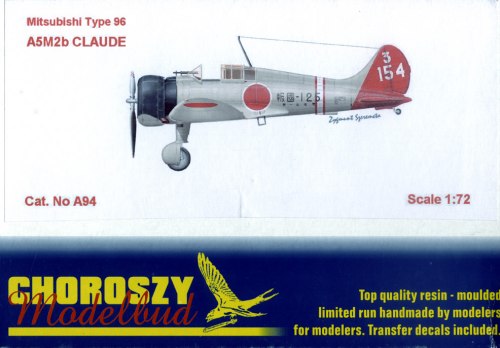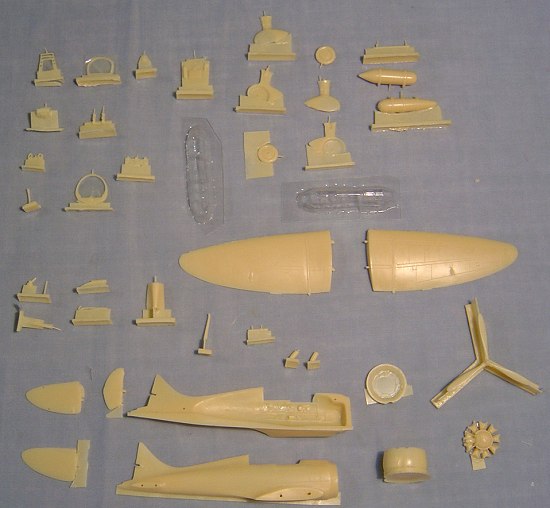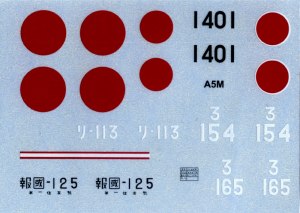
|
KIT: |
Choroszny Modelbud 1/72 A5M2b 'Claude' |
|
KIT # |
A 94 |
|
PRICE: |
$27.00 |
|
DECALS: |
Four options |
|
REVIEWER: |
Bill Sandborn |
|
NOTES: |
Resin with a vac canopy |

|
HISTORY |
The Mitsubishi Type 96 Carrier Fighter (A5M) gained fame for being the world’s first operational carrier based, low-wing monoplane fighter. It was designed by Jiro Horikoshi, who later became famous as the designer of the A6M Zero. The design incorporated many unique features and gave the Japanese aeronautical engineers confidence that they could produce designs that could complete on the world stage. The aircraft began flight trials in February 1935 with the first delivery of the A5M1s to units in early 1937. As the Sino-Japanese conflict flared in July 1937, the A5M2a began supplanting the earlier version. These planes established air superiority in the skies over China. Development of the design continued and the A5M2b incorporated a redesigned cowling and an enclosed canopy as well as other equipment changes dictated by combat experiences. The pilots disliked the enclosed canopy and many units removed all the glazing behind the windscreen. The A5M2b was redesigned to include an open cockpit. Further developments of the design included the unsuccessful inline engined A5M3 and the definitive version of the plane, the A5M4. By 1941, most A5M had been relegated to second line roles. Even so, the Allies gave the A5M the code name CLAUDE. In 1942, the A5M4-K two-seat trainer became operational. CLAUDEs ended the war as so many other types, they died as kamikazes.
The A5M2b was an all metal aircraft with fabric covered control surfaces and fixed undercarriage. The version depicted by this kit is an early A5M2b with an enclosed canopy. It was powered by a 640 hp 9-cylinder Kotobuki 3 radial engine driving a metal variable-pitch three-blade propeller. All operational versions carried two fixed forward-firing 7.7mm Type 89 machine guns in the upper decking of the fuselage. Two 30 kg bombs could be carried outboard of the landing gear and an external fuel tank could be slung on a centerline rack.
|
THE KIT |

To the best of my knowledge, this is the only available kit of this version of the CLAUDE. The A5M2b is beautifully cast with fine details in tan resin. The kit has about 40 resin parts. The molding is crisp with some flash. There is a fair amount of flash; however it is not excessive with most occurring where needed to preserve fragile parts. The clean up will require some time to remove all the flash and to detach the parts from the casting frets, however no more clean-up than the typical resin kit will be required. The craftsmanship is excellent with some bubbles. There are a few more bubbles than previous Choroszy releases, but again they are not excessive and are easily fixed.
 The kit has a full
interior and very fine surface detail. The fuselage is as thin as many
plastic kits, but does not seem fragile. It includes well printed thin
decals for 4 aircraft (three in pre-war silver with red and the 4th
appears to be the markings for the KI-18 prototype, but this version
cannot be made from this kit, maybe a hint for a future kit?). The kit
scales-out basically bang-on. All measurements were within a millimeter
or less of the dimensions listed in reference 3. The kit instructions do
not include options, but there are two drop tanks included. A check of
the photos in the references shows that both types could be used on this
version. Additionally from the references, some planes of this version
were flown with all the glazing behind the windscreen removed. With some
minor additions to the part behind the pilot, this variant could be
modeled as well. While going over the kit (as I am frequently finding
out with Choroszy kits), I found details that had not previously caught
my attention on a CLAUDE. Sure enough, when I checked my references
photos, they were there. Choroszy Modelbud has done their homework as
usual! Thanks!
The kit has a full
interior and very fine surface detail. The fuselage is as thin as many
plastic kits, but does not seem fragile. It includes well printed thin
decals for 4 aircraft (three in pre-war silver with red and the 4th
appears to be the markings for the KI-18 prototype, but this version
cannot be made from this kit, maybe a hint for a future kit?). The kit
scales-out basically bang-on. All measurements were within a millimeter
or less of the dimensions listed in reference 3. The kit instructions do
not include options, but there are two drop tanks included. A check of
the photos in the references shows that both types could be used on this
version. Additionally from the references, some planes of this version
were flown with all the glazing behind the windscreen removed. With some
minor additions to the part behind the pilot, this variant could be
modeled as well. While going over the kit (as I am frequently finding
out with Choroszy kits), I found details that had not previously caught
my attention on a CLAUDE. Sure enough, when I checked my references
photos, they were there. Choroszy Modelbud has done their homework as
usual! Thanks!
I would recommend this kit to the average modeler who is not afraid of building a resin kit. The kit parts are well packaged in 5 separate small zip-lock type bags. The kit also contains 2 duplicate vacu-formed canopies. I always appreciate duplicates as I invariably damage one during construction. The canopies are clear, but have heavy, out-of-scale framing. The directions consist of 2 sheets front and back. (One side for the three-view of the plane, one half side for history, 1 and a half for the exploded view construction directions, and one side for the camouflage schemes). The exploded views are not crowded and most modelers will be able to follow them. One drawback is that some of the interior parts are not detailed in the views. Using the available references, the average modeler will have little problem figuring out where they belong. With all the interior detail parts that Choroszy Modelbud provides, many modelers will want to super detail the cockpit. However, this is not needed as it will look great even if you don't add a thing! Overall, the heavy detail on the clear parts and the omissions from the instructions may be the only draw backs to this kit.
|
CONCLUSIONS |
The full canopy version of the A5M2b is a welcome addition that will complement the Fujimi CLAUDE series. An average modeler will have no problems constructing this model and I look forward to building this kit! I also cannot wait to picking up the Choroszy’s other CLAUDE releases: the A5M4-K (kit# A92) and the A5M3 (kit# A93). Both of these have also never been produced in 1/72 previously. This leaves only the earliest A5Ms (A5M1 and early A5M2a) absent in this scale. In general, Choroszy kits are hand-made, limited-production, museum quality kits and you get what you pay for.
|
REFERENCES |
1) Famous Airplanes of the World #27, Type 96 Carrier Fighter, Bunrindo Publishing, March 1991.
2) Francillon, R. J., Japanese Aircraft of the Pacific War, Naval Institute Press, 1988.
3) The Maru Mechanic #49, Mitsubishi Type 96 Carrier Fighter/ Nakajima KI-27, Kojinsha Publishing, November 1984.
4) Model Art Special #510, Camouflage & Markings of the I.J.N. Fighters, Model Art Modeling Magazine, March 1998.
The Author wishes to thank Choroszy Modelbud (http://www.modelbud.pl/index_eng.htm ) for the evaluation sample.
If you would like your product reviewed fairly and quickly by a site that has nearly 250,000 visitors a month, please contact me or see other details in the Note to Contributors.